Prepare yourself for a wild journey through Tennessee’s lakes and rivers, where nature’s most formidable creatures lurk beneath the serene surface. These dangerous animals, hidden within the depths, evoke both awe and fear. With razor-sharp instincts and astonishing adaptations, they have survived millennia, silently observing the world above.
Hold your breath as we are about to list some of the most dangerous animals found in Tennessee’s lakes and rivers. Let’s dive in!

Prepare yourself for a wild journey through
Tennessee’s lakes and rivers
.
©BEN MOONEY/Shutterstock.com
Are Tennessee’s Lakes And Rivers Dangerous?
Tennessee’s lakes and rivers can potentially host various animal species, but the danger they pose to humans is generally low. While encounters with wildlife are possible, such as snakes, alligators, or water-dwelling creatures, these incidents are rare and typically avoidable by practicing basic safety measures.
It is advisable to be aware of one’s surroundings, respect wildlife habitats, and follow any guidelines or restrictions in place.

A List Of The Most Dangerous Animals In Tennessee’s Lake And Rivers
Here are the most dangerous animals you can face in Tennessee’s lakes and rivers.
1. Alligator Gar (Atractosteus spatula)
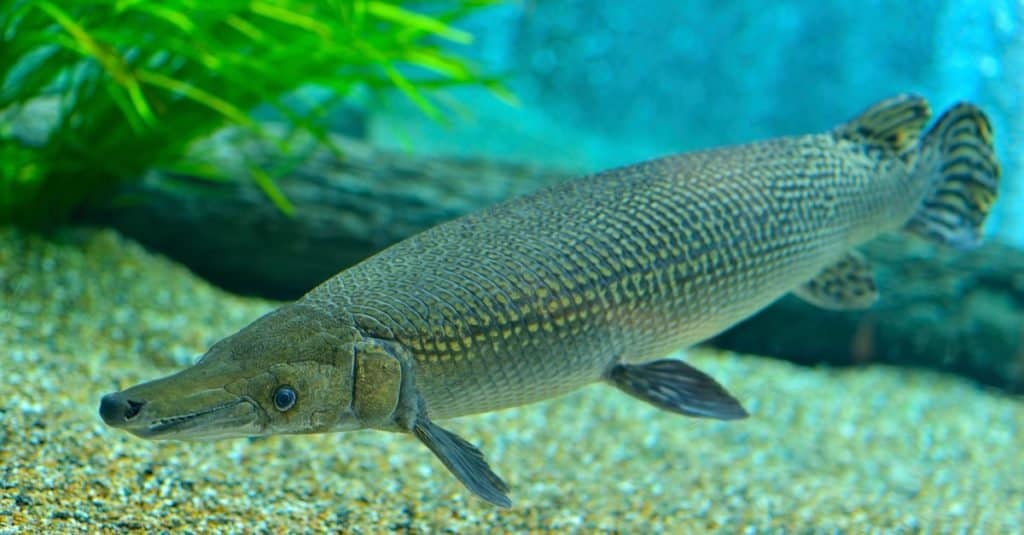
While alligator gar is generally not aggressive, caution is necessary when attempting to catch and handle these powerful creatures.
©tristan tan/Shutterstock.com
The alligator gar, found in Tennessee, is the largest member of the gar family and one of the largest freshwater fish in North America.
With their distinctive features of elongated, slender bodies, long snouts, and diamond-shaped interlocking scales, gars easily stand apart from other species in freshwater environments. In addition, their rounded tail fins and well-positioned dorsal and anal fins contribute to their unique appearance.
Growing up to 10 feet long, these remarkable fish inhabit slow-moving rivers, reservoirs, and oxbow lakes. Before taking a dip, it’s wise to check the waters, as disturbing an alligator gar can lead to unforeseen consequences.
Notably, the scales of alligator gar differ from those of other fish. These ganoid scales, resembling bone, possess rhomboidal shapes and often feature serrated edges protected by an enamel-like substance.
While alligator gar is generally not aggressive, caution is necessary when attempting to catch and handle these powerful creatures. With their mouthful of sharp teeth and bony scales, mishandling these fish can result in cuts or bruises if anglers aren’t careful.
2. Cottonmouth Snake (Agkistrodon piscivorus)
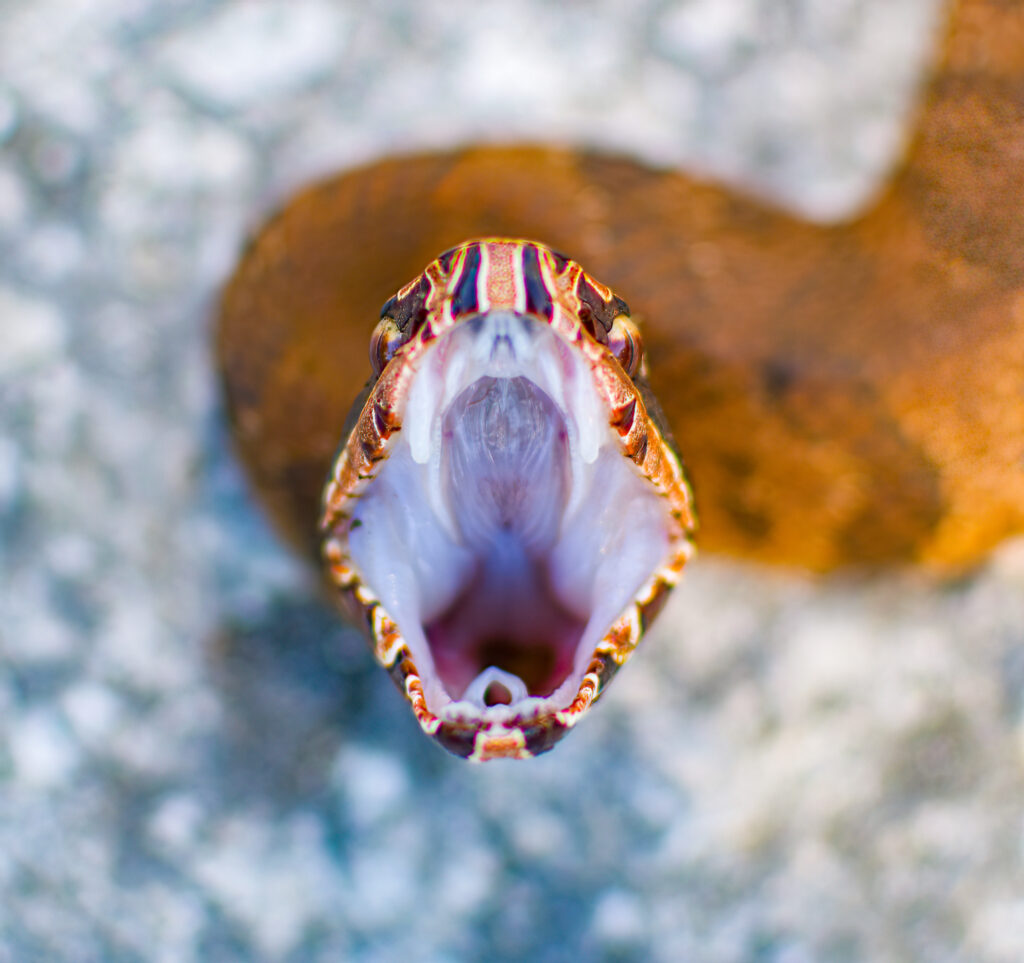
Cottonmouth snakes
are known for their sturdy and dark features, having thick bodies and venomous traits.
©iStock.com/Chase D’animulls
The western area of Tennessee hosts a venomous snake species often called “water moccasins” or cottonmouth snakes.
Cottonmouth snakes are known for their sturdy and dark features, having thick bodies and venomous traits. When alarmed or scared, these snakes show a unique behavior of opening their mouths wide, displaying a bright white color inside, which inspired the name “cottonmouth.” Adult cottonmouths usually measure 30 to 42 inches long and exhibit a mostly dark, grayish-brown hue with little or no markings.
While they favor habitats like lowland swamps, lakes, rivers, and salt marshes, cottonmouths aren’t restricted to wet environments exclusively.
It is vital not to downplay the danger linked to these snakes. Cottonmouth bites can lead to various symptoms, such as swelling, bruising, blisters, or bleeding. The affected area might also experience intense pain and sensitivity.
Moreover, people bitten by a cottonmouth could face vomiting, nausea, diarrhea, or even breathing difficulties, potentially leading to respiratory failure in severe cases.
Although cottonmouths represent under 1% of snakebite-related deaths in the United States, it’s essential to acknowledge that their venomous bites can present significant risks to humans and pets alike. As a consequence, immediate medical care should be sought from a knowledgeable physician or a hospital experienced in treating snakebites.
Fortunately, cottonmouths generally display non-aggressive tendencies and tend to steer clear of direct contact with humans and pets.
3. Alligator Snapping Turtle (Macrochelys temminckii)

Featuring a large head, strong jaws, and a curved beak, the alligator
snapping turtle
has a unique appearance.
©Sista Vongjintanaruks/Shutterstock.com
Primarily residing in the western third of the state, with occasional sightings in central areas, the alligator snapping turtle is recognized as the largest turtle in North America.
Featuring a large head, strong jaws, and a curved beak, the alligator snapping turtle has a unique appearance. Its carapace, a spiky shell, is dark brown in color. They can reach a size of 30 inches.
Occupying a range of aquatic habitats like rivers, lakes, and backwater swamps, the alligator snapping turtle enjoys diverse surroundings. While some misconceptions imply that these turtles threaten humans, it is crucial to understand that this is untrue.
It is best to exercise caution when coming across these turtles due to the tremendous force of their powerful jaws. Therefore, it is strongly recommended to refrain from handling them as a single bite can easily break bones!
Luckily, alligator snapping turtles only become dangerous to humans when provoked or bothered. When underwater, these turtles are incredibly docile and make great efforts to evade human contact.
4. Blue Catfish (Ictalurus furcatus)
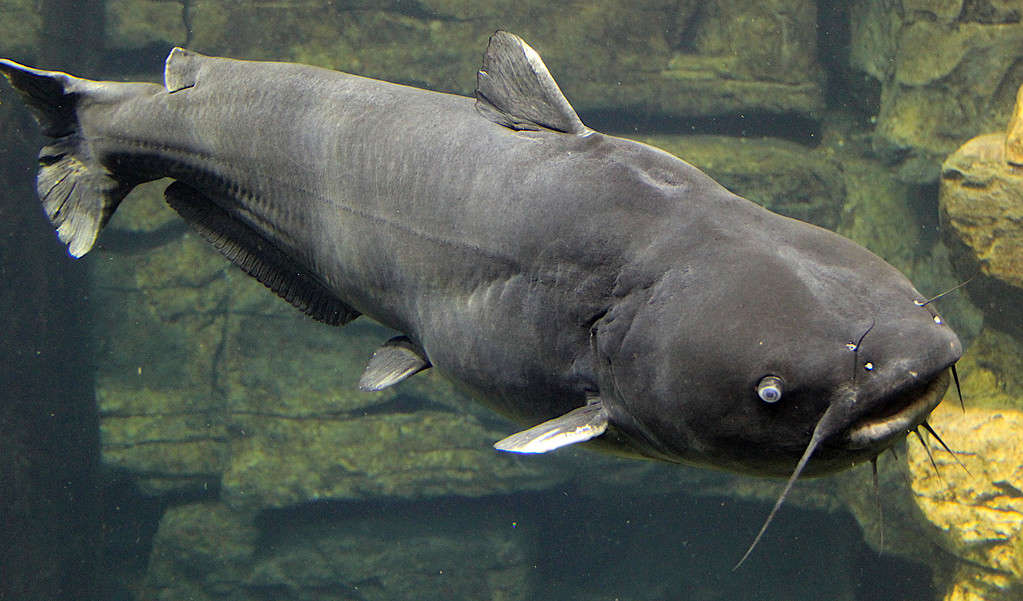
Although blue
catfish
aren’t typically aggressive to humans, it is essential to be careful when handling or interacting with them.
©Thomsonmg2000, cropped and adjusted by Kostka Martin / CC0 – License
The North American blue catfish is the largest species within its family, with lengths ranging from 25 to 46 inches. These impressive creatures typically reside near the riverbeds of vast rivers, preferring deep channels, fast currents, and sandy substrates provided by these rivers.
Easily recognizable by their unique physical attributes, blue catfish have a flat dorsal fin and a deeply forked tail. Displaying a gleaming silvery-blue shade on their bodies, accompanied by a pure white underside, these fish feature smooth skin without scales. Furthermore, four pairs of dark, whisker-like barbels decorate their mouths.
Although blue catfish aren’t typically aggressive to humans, it is essential to be careful when handling or interacting with them.
Improper handling or agitating these creatures can lead to injuries and a severe sting. Their pectoral and dorsal fins possess rigid, sharp spines capable of piercing the skin and causing cuts. These spines are connected to venom glands, which might release toxins if the fish feels threatened or irritated. While the venom typically isn’t harmful to humans, it can cause significant pain and swelling.
Properly cleaning and treating any injuries resulting from contact with these spines is crucial to reduce the risk of infection.
5. American Alligator (Alligator mississippiensis)

Alligators are dangerous and inhabit many southern U.S. waters.
©iStock.com/Cindy Larson
In Tennessee, sightings of American alligators are quite rare. These impressive animals exhibit strong, armored bodies and flat, muscular tails. Bony plates, known as osteoderms or scutes, shield their backs. The alligator has four legs, with five toes on the front limbs and four on the back limbs.
Commonly found in freshwater habitats, such as sluggish rivers, alligators also reside in swamps, marshes, and lakes. Although they are not typically aggressive, they will protect themselves or their nests if they sense danger.
Out of all alligator incidents recorded in the United States, approximately 4% have resulted in fatalities. It is essential to emphasize that such events are rare. However, caution is still necessary, as crocodile or alligator bites can lead to deaths or, if the victim survives, a high risk of infection.
Interestingly, alligators have the strongest bite force ever recorded, achieving up to 2,000 pounds per square inch. In contrast, lions exert roughly 600 pounds, and humans manage a mere 120 pounds per square inch. Given this impressive strength, it is wise to maintain a safe distance when near an American alligator.
Dangerous Animals Around Tennessee’s Lakes And Rivers
In addition to the lakes and rivers of Tennessee, the surrounding areas offer ideal habitats for several dangerous wildlife species. Here are a few examples:
1. Copperhead Snake (Agkistrodon contortrix)
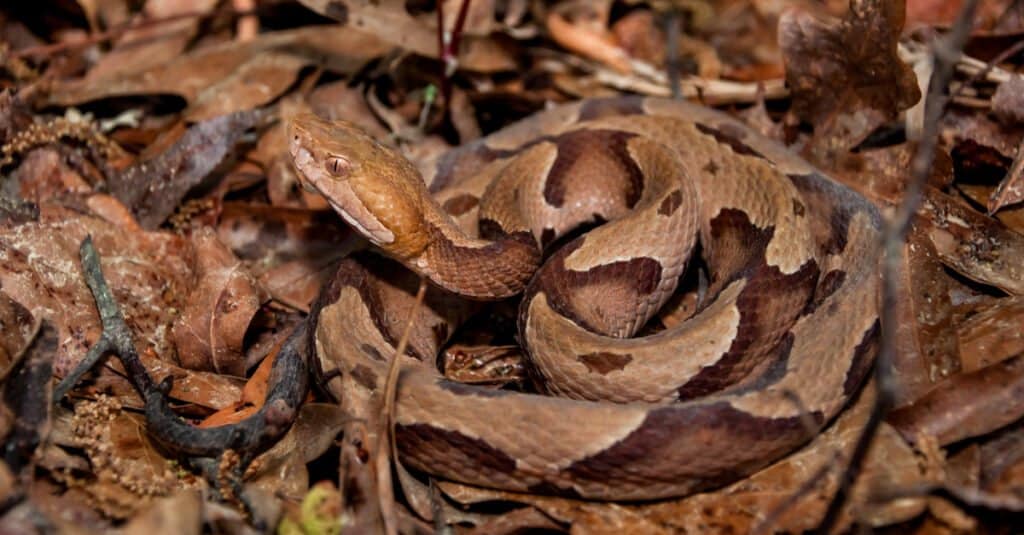
While the venom of this snake is considered less potent compared to other pit
vipers
, underestimating it would be unwise.
©Jay Ondreicka/Shutterstock.com
Tennessee is home to four venomous snakes, among which the copperhead stands out as a pit viper widely distributed across the entire state.
With its distinct features, the copperhead showcases a broad head of a striking copper hue, complemented by a body of reddish-tan coloration. Darker hourglass-shaped marks adorn its back, while its underside displays a pleasant pinkish shade. In terms of size, adult copperheads can reach lengths of approximately 3 feet.
While the venom of this snake is considered less potent compared to other pit vipers, underestimating it would be unwise. A bite from a copperhead brings about instant and severe consequences, including rapid swelling accompanied by intense pain. The affected area may also exhibit visible bruising, and breathing difficulties may arise. Furthermore, one may experience changes in heart rate or rhythm, and a peculiar taste resembling metal, rubber, or mint might be detected in the mouth.
Most snake bites occur as a result of intentional provocation or accidental encounters, such as inadvertently stepping on the snake.
2. Black Bear (Agkistrodon contortrix)

Although black bear attacks are uncommon, 61 fatalities have been attributed to them in North America since 1900.
©Menno Schaefer/Shutterstock.com
Tennessee is home to an estimated population of 5,500 to 6,000 black bears, showcasing a variety of coat colors from shaggy black to dark brown, cinnamon, or yellow-brown.
These bears often have brown eyes, which may appear blue during their early life stages. Measuring about 4 to 7 feet in length from nose to tail and standing around 2 to 3 feet tall at the shoulders, black bears exude a powerful presence.
Although black bear attacks are uncommon, 61 fatalities have been attributed to them in North America since 1900. Therefore, it is essential to approach interactions with these animals cautiously and respectfully, giving them ample space.
Black bears possess a bite force of up to 800 pounds per square inch (psi) and an average tooth length of 2.5 inches, giving them a strength five times greater than the average human. Despite the remote possibility, a black bear is capable of causing severe, even lethal, harm with a single swipe.
Thankfully, actual bear attacks are rare events.
3. Striped Skunk (Mephitis mephitis)
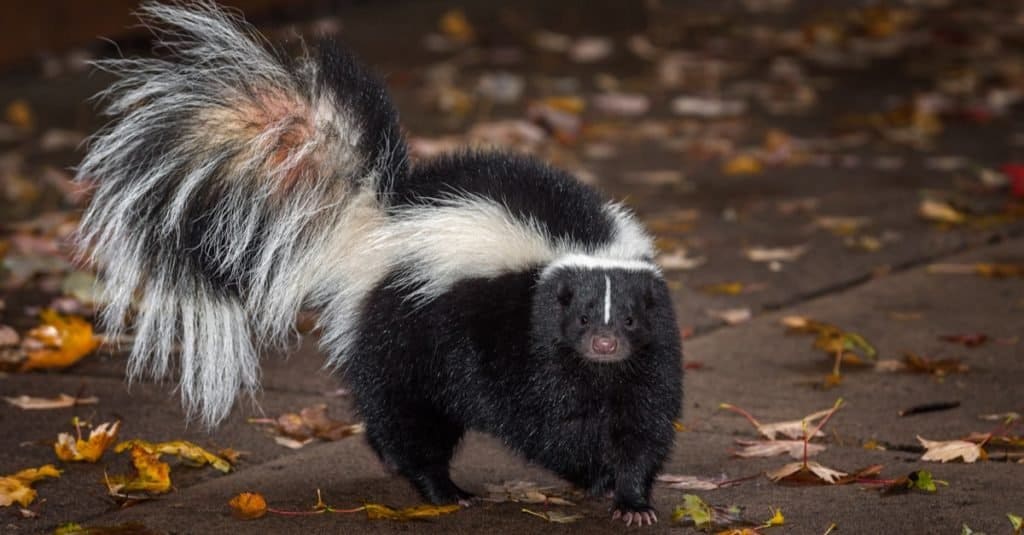
One of the skunk’s most remarkable attributes is its defensive mechanism.
©Geoffrey Kuchera/Shutterstock.com
The striped skunk is widely found throughout Tennessee and is considered the most prevalent species in the state. This mammal has a stout build with medium-sized proportions, featuring a small head, short legs, and a distinct, bushy tail.
One of the skunk’s most remarkable attributes is its defensive mechanism. When threatened, it can discharge a noxious fluid from glands near the base of its tail. While generally non-confrontational, the striped skunk can accurately spray its target up to a distance of 15 feet, with its highest precision observed within 10 feet. Apart from the foul odor, this fluid can cause intense pain and temporary loss of vision if it comes into contact with the eyes.
Due to their abundant presence, striped skunks are susceptible to various diseases, including rabies. Infected skunks exhibit altered behavior, which distinguishes them from their healthy counterparts. Signs of infection include increased daytime activity and aggression. In some cases, skunks may resort to biting if approached.
4. American Dog Tick (Dermacentor variabilis)
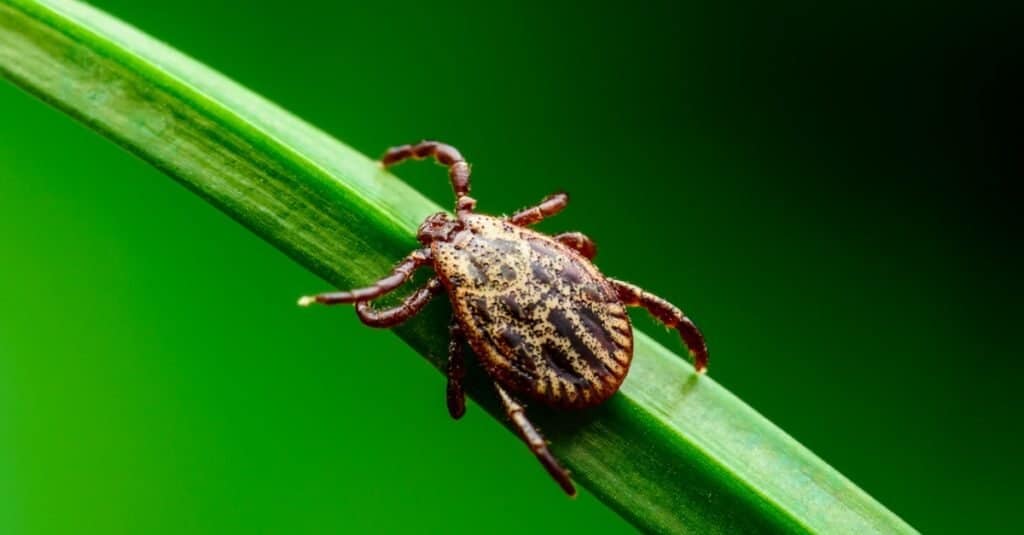
Due to their prevalence in
wood
ed areas, these ticks are often referred to as wood ticks.
©iStock.com/nechaev-kon
In the state of Tennessee, there is a diverse range of tick species, with an estimated count of up to 15. Among these species, the American dog tick stands out as one of the most commonly encountered ticks in the region.
American dog ticks possess an oval and flattened shape, characterized by a brown coloration accompanied by whitish-to-gray markings. Due to their prevalence in wooded areas, these ticks are often referred to as wood ticks. Additionally, they can be found near bodies of water, where animals quench their thirst.
The American dog tick displays highly aggressive behavior and poses a significant threat. Female ticks actively seek warm locations, such as beneath blankets or in dogs’ fur, where they attach themselves to their hosts. Once attached, a tick can remain on its host for up to two days before detaching.
Bites from American dog ticks can result in fever, itches, and even tick paralysis. It is crucial to remain vigilant for the development of rashes surrounding tick bites, as this serves as the primary symptom for diseases such as tularemia and Rocky Mountain spotted fever.
The American dog tick carries bacteria that are responsible for causing diseases in humans, notably Rocky Mountain spotted fever. These pathogens are transmitted when the ticks feed on their hosts’ blood. The period of greatest risk for encountering these ticks is during the spring and early summer months.
The photo featured at the top of this post is © Danita Delimont/Shutterstock.com
Thank you for reading! Have some feedback for us? Contact the AZ Animals editorial team.






